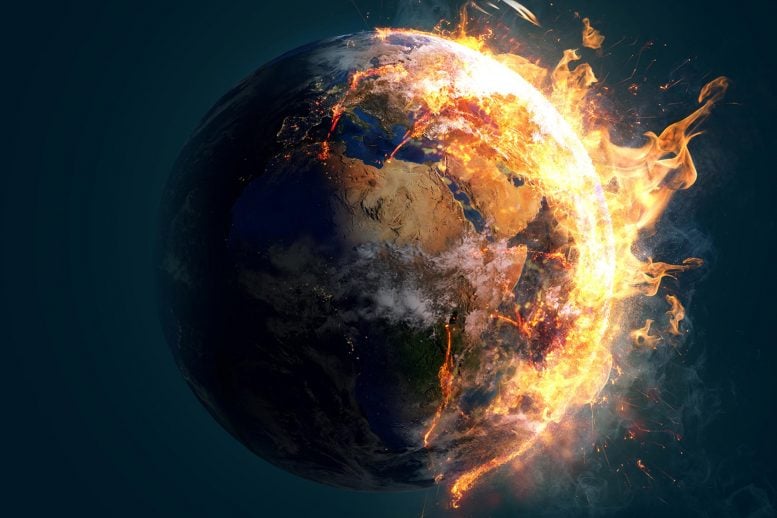
Current climate policies are expected to result in 22% of the world’s population exposed to dangerous heat levels by 2100, according to a study from the Global Systems Institute, University of Exeter, and Nanjing University. Limiting global warming to 1.5°C, compared to the projected 2.7°C, would reduce this figure to 5%, underscoring the urgent need for robust climate policies and greenhouse gas emissions reduction.
New research suggests that more than 20% of the global population could be subjected to severe heat conditions by the year 2100 due to current climate strategies.
The commitments outlined in the Paris Agreement aim to restrict the global temperature rise to less than 2°C relative to pre-industrial times. However, based on current policies, the world is anticipated to witness a temperature rise of about 2.7°C by the end of this century.
The new study, led by researchers at the Global Systems Institute, University of Exeter, associated with the Earth Commission, and Nanjing University, assessed what this would mean for the number of people living outside the “climate niche” in which our species has thrived.
It says about 60 million people are already exposed to dangerous heat (average temperature of 29°C or higher).
And two billion – 22% of the projected end-of-century population – would be exposed to this at 2.7°C of global warming.
The paper highlights the “huge potential” for decisive climate policy to limit the human costs and inequities of climate change.
Limiting warming to 1.5°C would leave 5% exposed – saving a sixth of humanity from dangerous heat compared to 2.7°C of warming.
The study also finds that the lifetime emissions of 3.5 average global citizens today – or just 1.2 US citizens – expose one future person to dangerous heat. This highlights the inequity of the climate crisis, as these future heat-exposed people will live in places where emissions today are around half of the global average.
In “worst-case scenarios” of 3.6°C or even 4.4°C global warming, half of the world’s population could be left outside the climate niche, posing what the researchers call an “existential risk”.
“The costs of global warming are often expressed in financial terms, but our study highlights the phenomenal human cost of failing to tackle the climate emergency,” said Professor Tim Lenton, director of the Global Systems Institute at the University of Exeter.
“For every 0.1°C of warming above present levels, about 140 million more people will be exposed to dangerous heat.
“This reveals both the scale of the problem and the importance of decisive action to reduce carbon emissions.
“Limiting global warming to 1.5°C rather than 2.7°C would mean five times fewer people in 2100 being exposed to dangerous heat.”
Defining the niche
Human population density has historically peaked in places with an average temperature of about 13°C, with a secondary peak at about 27°C (monsoon climates, especially in South Asia).
The density of crops and livestock follow similar patterns, and wealth (measured by GDP) peaks at about 13°C.
Mortality increases at both higher and lower temperatures, supporting the idea of a human “niche”.
Although less than 1% of humanity currently lives in places of dangerous heat exposure, the study shows climate change has already put 9% of the global population (more than 600 million people) outside the niche.
“Most of these people lived near the cooler 13°C peak of the niche and are now in the ‘middle ground’ between the two peaks. While not dangerously hot, these conditions tend to be much drier and have not historically supported dense human populations,” said Professor Chi Xu, of Nanjing University.
“Meanwhile, the vast majority of people set to be left outside the niche due to future warming will be exposed to dangerous heat.
“Such high temperatures have been linked to issues including increased mortality, decreased labor productivity, decreased cognitive performance, impaired learning, adverse pregnancy outcomes, decreased crop yield, increased conflict, and infectious disease spread.”
While some cooler places may become more habitable due to climate change, population growth is projected to be highest in places at risk of dangerous heat, especially India and Nigeria.
The study also found:
- Exposure to dangerous heat starts to increase dramatically at 1.2°C (just above current global warming) and increases by about 140 million for every 0.1°C of further warming.
- Assuming a future population of 9.5 billion people, India would have the greatest population exposed to 2.7°C global warming – more than 600 million. At 1.5°C, this figure would be far lower, at about 90 million.
- Nigeria would have the second-largest heat-exposed population at 2.7°C global warming, more than 300 million. At 1.5°C warming, this would be less than 40 million.
- India and Nigeria already show “hotspots” of dangerous temperatures.
- At 2.7°C, almost 100% of some countries including Burkina Faso and Mali will be dangerously hot for humans. Brazil would have the largest land area exposed to dangerous heat, despite almost no area being exposed at 1.5 °C. Australia and India would also experience massive increases in area exposed.
The research team – which included the Potsdam Institute for Climate Impact Research, the International Institute for Applied Systems Analysis, and the Universities of Washington, North Carolina State, Aarhus, and Wageningen – stress that the worst of these impacts can be avoided by rapid action to cut greenhouse gas emissions.
Speaking about the conception of their idea, Professor Marten Scheffer, of Wageningen University, said: “We were triggered by the fact that the economic costs of carbon emissions hardly reflect the impact on human wellbeing.
“Our calculations now help bridge this gap and should stimulate asking new, unorthodox questions about justice.”
Ashish Ghadiali, of Exeter’s Global Systems Institute, said: “These new findings from the leading edge of Earth systems science underline the profoundly racialized nature of projected climate impacts and should inspire a policy sea-change in thinking around the urgency of decarbonization efforts as well as in the value of massively up-shifting global investment into the frontlines of climate vulnerability.”
Reference: “Quantifying the human cost of global warming” by Timothy M. Lenton, Chi Xu, Jesse F. Abrams, Ashish Ghadiali, Sina Loriani, Boris Sakschewski, Caroline Zimm, Kristie L. Ebi, Robert R. Dunn, Jens-Christian Svenning and Marten Scheffer, 22 May 2023, Nature Sustainability.
DOI: 10.1038/s41893-023-01132-6
The research was funded by the Open Society Foundations and the paper is also an output of the Earth Commission – convened by Future Earth, the Earth Commission is the scientific cornerstone of the Global Commons Alliance.
Wendy Broadgate, Executive Director of the Earth Commission at Future Earth, said: “We are already seeing effects of dangerous heat levels on people in different parts of the world today. This will only accelerate unless we take immediate and decisive action to reduce greenhouse gas emissions.”
Work on climate solutions by the Global Systems Institute at the University of Exeter has identified “positive tipping points” to accelerate action, including a recent report that highlighted three “super-leverage points” that could trigger a cascade of decarbonization.









Assuming that anthropogenic CO2 is actually the driving force behind rising temperatures, the best, no regrets approach, is to increase support for solving the problem of controlled thermonuclear fusion. The CO2 issue will be taken care of by people willingly switching to cheaper fusion powered electricity. If temperatures continue to rise, we will discover that CO2 isn’t driving the changes without having to make changes that decrease our standard of living, decrease our disposable income, and use up vast acreage for turbines and solar arrays.
We need the equivalent of another Manhattan Project, with different engineering approaches.
Depending only on nuclear fusion and not taking other actions will most probably mean that the warming will exceed 2C. Easier to tax fossil fuels (including aviation and shipping) with an annually increasing %. This will encourage use of alternatives and help fill empty government treasuries.
“Our calculations now help bridge this gap and should stimulate asking new, unorthodox questions about justice.”
How about asking “unorthodox questions” like, Why is it that “India and Nigeria already show ‘HOTSPOTS’ of dangerous temperatures?” And, what is meant by “Exposure to dangerous heat starts to increase dramatically at 1.2°C”? Why “population growth is projected to be highest in places at risk of dangerous heat,” when warming is supposed to have so many negative impacts? Why is there no mention of humidity or Heat Index?
Population growth is not dependent on temperature, but on equal access to education, including sex education, access to contraception and a good social net including pensions. Dangerous conditions will increase the birth rate as the survival rate is decreased.